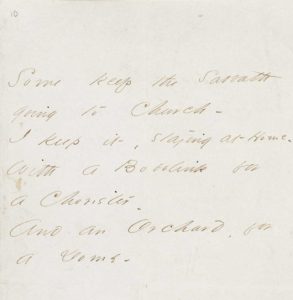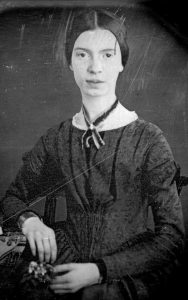Born roughly a generation after Ralph Waldo Emerson, Margaret Fuller, and Henry D. Thoreau, Dickinson was a child when the Transcendental club was meeting regularly and just fourteen years old when The Dial published its last issue in 1844. Yet a glance at an 1852 poem of Dickinson’s reveals the depth of her poetry’s affinity with Transcendentalist thought and philosophy:
I keep it, staying at Home –
With a Bobolink for a Chorister –
And an Orchard, for a Dome –

Along with many of her Transcendentalist precursors, the Amherst-born Dickinson challenged the dogmatic religious doctrine that suffused the atmosphere of her upbringing and education. Biographers trace her iconoclasm to her early years: when the headmistress of Mount Holyoke’s Female Seminary (where Dickinson attended for a year before withdrawing) asked students to publicly declare their Christian faith by rising from their seats, the young Dickinson refused to stand.
Like Emerson and Thoreau, Dickinson was informed by the British Romantic poetry and philosophy that located divinity in mountains, rivers, and woods, poetry that encouraged readers to pay closer and more reverential attention to the natural phenomena threatened by increasing industrialization. The speaker of the Dickinson poem quoted above, for example, finds the sacred in birdsong and a cathedral of apple trees rather than in church pews and hymns. Another poem pays homage to the “Sacrament of summer days,” vesting “belief” in the bee and bearing reverent “witness” to “ranks of seeds.” Thoreau, for his part, recounted in A Week on the Concord and Merrimack Rivers that he was “reproved by a minister…because I was bending my steps to a mountain-top on the Sabbath, instead of a church.”
Yet while Dickinson challenged conventional definitions of faith and salvation, she was not interested in—and recognized the impossibility of—fully renouncing the Christian metaphysics of eternity and immortality undergirding her conceptualization of time and the cosmos. “Why—do they shut Me out of Heaven? / Did I sing—too loud?,” begins another of her poems. Questions like these suggest that the speaker’s song—Dickinson’s poetry—often deviates from the traditional meter of the church hymn and challenges orthodox modes of religious participation. The practice of wrestling with and synthesizing vastly different existential approaches to experience sets Dickinson apart as one of the most intellectually ingenious and formally inventive poets of her day.

It is unclear whether Thoreau knew of Dickinson’s existence, but the possibility is unlikely; Dickinson maintained a selective coterie of epistolary correspondents to whom she sent her poetry, and Thoreau was not a member of this circle (Thoreau’s friend and associate Thomas Wentworth Higginson was, however, one of Dickinson’s prized interlocutors.) The four or five poems of Dickinson’s that were published in Thoreau’s lifetime were printed without attribution and in The Springfield Daily Republican, a Western Massachusetts-based paper the Concordian Thoreau would not likely have read.
Dickinson was, however, familiar with Thoreau’s writing. Contained within the Dickinson family library was a copy of A Week on the Concord and Merrimack Rivers with the inscription “E. Dickinson,” two copies of Walden, and Letters to Various Persons. Two of Dickinson’s letters mention Thoreau: in 1866, Dickinson asked her sister-in-law Susan Gilbert Dickinson, who was on holiday at the seashore, “Was the Sea cordial? Kiss him for Thoreau –.” Dickinson editor Thomas H. Johnson surmised that Dickinson’s reference to Thoreau and the sea alluded to Thoreau’s Cape Cod, which had been published the previous year. In a letter written fifteen years later, Dickinson noted with equal parts earnestness and irony that “The fire-bells are oftener now, almost, than the church-bells. Thoreau would wonder which did the most harm.” (In Walden, Thoreau wrote “If I should only give a few pulls at the parish bell-rope, as for a fire, that is, without setting the bell, there is hardly a man on his farm in the outskirts of Concord…but would forsake all and follow that sound, not mainly to save property from the flames.”) These references of Dickinson’s to Thoreau are brief but knowing.
Like Thoreau, Dickinson possessed an eye simultaneously attuned to the minutest of natural phenomena and to the largest of metaphysical abstractions. For every poem of Dickinson’s that conceives of the architecture of eternity there is another that investigates the intricate industries that sustain the lives of plants and insects. Thoreau, for his part, weaves between deep history and in-the-moment observation, waxing philosophical on the “characteristics and pursuits of various ages and races of men” while describing in great detail how the movements of different types of fish scatter sunlight across water. Perhaps this kind of double vision makes sense. Because the philosophically-bent Thoreau and Dickinson spent most of their time in the towns in which they grew up, their sustained knowledge of their surrounds through all kinds of weather attuned their perception to the rich variety of flora and fauna in the local landscape, and they were able to track subtle seasonal changes others failed to observe, let alone render in writing.
Sources Consulted
Buell, Lawrence. Thinking Deliberately (2023)
Johnson, Thomas (ed). Letters of Emily Dickinson (1997)
Miller, Cristanne (ed). Emily Dickinson’s Poems: As She Preserved Them (2016)
Thoreau, Henry D. A Week on the Concord and Merrimack Rivers (1849)

